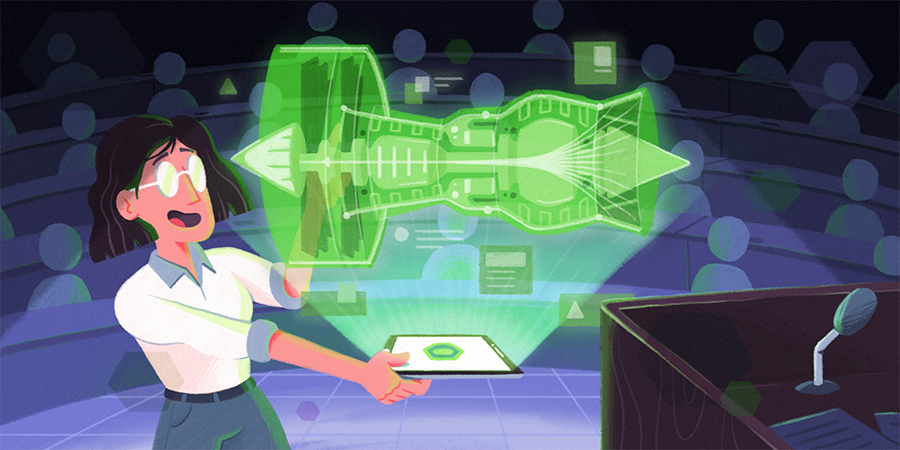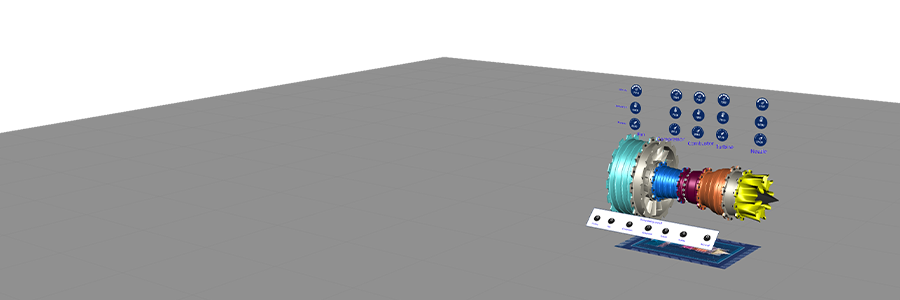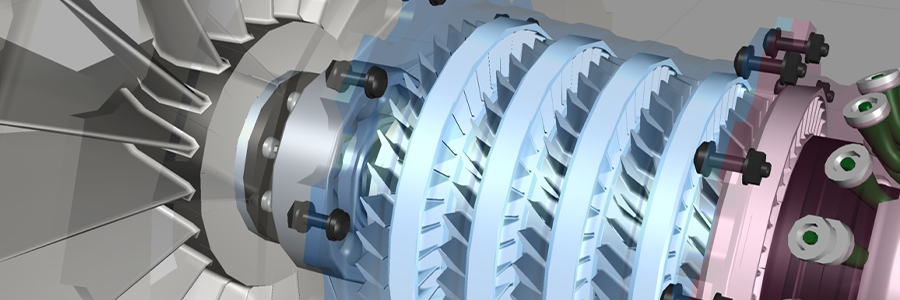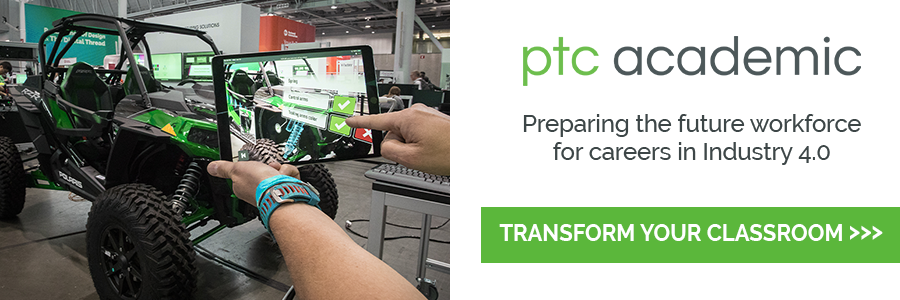
Augmented reality (AR) can prove a useful tool in the classroom for simulating exposure to an environment, set of tasks, or product when it is not possible to introduce students to the real thing. By implementing realistic re-creations of these elements in the form of AR experiences, students are given the chance to explore and learn in ways they might not be able to otherwise.
Let's take a look at the various AR applications:
Consider a typical mechanical engineering course in which students study machine components such as bearings. Most students enter a course like this having little or no familiarity with these types of components, let alone the machines where they might be used – in this case, a jet engine.
Now say, for example, that the students were asked to calculate the load on the front bearing of a jet engine. They would be given weight, thrust and other relevant information, as well as a 2D representation of the bearing as shown below.
They may even be given the jet engine cross-section, but as you can see from the image show below, understanding what the front bearing is and where it is located in the jet engine is difficult, especially if the student has had no prior exposure.

2D ball bearing diagram and 2D Commercial jet engine cross section diagram.
Teaching these concepts to new engineering students would be much easier if they could interact with the actual machine they are studying. But due to cost, access, and a variety of other factors, it is not currently feasible to bring a jet engine into every engineering classroom. This is where AR comes in.
The PTC Academic team designed an AR experience for viewing a jet engine that illustrates this concept more clearly. The experience shows a model of a turbine with its different components (fan, compressor, combustor, turbine, and nozzle) color coded.
There is also simulated data corresponding to each section with dials for velocity, temperature, and pressure. While this data is merely simulated, it shows the potential for feeding in actual data using the Internet of Things (IoT).
There is a control interface that allows the user to toggle the transparency of each component on and off in order to be able to see inside the engine, and also toggle on and off a diagram of the air flow as it interacts with the engine.

The Commercial Jet Engine AR Experience shown with the different components color coded, simulated data shown above corresponding to each component and a control interface at the bottom.
The experience uses an image target deployment method, meaning that it tracks to a printed diagram rather than just anywhere in 3D space. This method gives the experience a sturdy platform to tether to and also allows the experience to scale to the size of the diagram. We have a large 4-foot banner that scales the experience almost to real size and represents the way a professor might want to show it to his or her students in the classroom. Alternatively, one could print the diagram on smaller pieces of paper to allow students to view it individually.
The graphic we designed and printed for the experience to track to.
Using this kind of immersive AR experience, students can interact with a 3D virtual jet engine that they can move into and explore, seeing with much greater ease where the bearing is and what it does. Immersive experiences like this one provide students with context that can make a big difference in their learning by allowing them to explore and interact with the model while also giving a sense of authenticity to the learning through simulation.

A close up of the jet engine shows the ball bearing in action.
Visiting a company that manufactures and tests jet engines would not accomplish the same purpose, since students would still be unable to see and move inside the engine. Additionally, the engine would remain inaccessible to students once the visit was over, whereas the AR experience allows for continued exploration and on-demand access throughout their coursework. Remember, a single immersive experience can provide authentic learning for a multitude of different homework assignments and lectures, so the key is identifying the right immersive experiences based on the specific curriculum of any given course.
To create an immersive experience, it is important to include a variety of features that enhance the viewing. In this example, not only were the jet engine components modeled but the turbine was animated and typical ranges of temperature, pressure and velocity were modeled. This allows students to interactively explore the jet engine machinery as well as its operation at a set point.
Building the immersive experience required creating CAD models of the machine components in Creo and then importing them into Vuforia Studio. Then, to stage the experience, we positioned the jet engine model above an image that would be used as the target to orient the experience. Next, we placed gauges with operating parameters above it in positions relative to the different sections of the engine. Finally, we added representations of the airflow, depicting how air flows through the components and creates thrust.
Building the AR experience also required some simple coding to simulate the rotation of the core of the engine and also the variations in the operating parameters displayed on the gauges. We coded the rotation using interval calls as shown, where frame is a function that incrementally rotates the core components of the engine:
$interval(frame, 10);
Simulating the operating parameters shown on the gauges involved setting up a separate interval function where a set of standard operating values are perturbed slightly to simulate typical operating behavior for each stage of the engine:
//set up the intervals for the fan data
$interval(function) {
fan_pressure_text = 21 + Math.floor(Math.random() * 10)
fan_temp_text = 5 + Math.floor(Math.random() * 5)
fan_velocity_text = 725 + Math.floor(Math.random() * 8)
}

The gauges simulate data that could be obtained from a real commercial jet engine.
Factors like cost, safety, feasibility, and access have always posed a challenge for engineering curricula as educators seek to prepare students for their future careers. Using AR, students can get real-world exposure to products, environments, and tasks in the classroom, in some cases providing greater value than bringing the actual object.

Dr. Cox has a Ph.D in Mechanical Engineering from Purdue University. Prior to joining PTC he taught for 25 years at Brigham Young University and consulted as a design systems specialist with aerospace companies like Honeywell and United Technologies. His research focused on advanced engineering analysis and design systems automation. He joined PTC in 2010 and currently is the Senior Vice President of the Global Academic Program. His team provides software, curriculum and other educational resources to more than 3,000 universities worldwide. Current interests include CAD/CAE/CAM, Digital Transformation, Neural Networks and Augmented Reality.
©Copyright 2025. All rights reserved by Modelcam Technologies Private Limited PUNE.